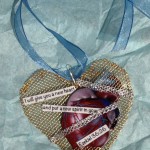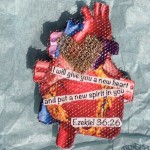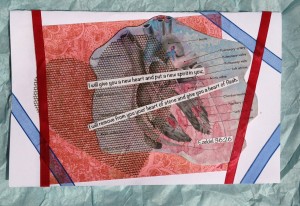Negative Space
The idea of negative space has intrigued me ever since I had an instructor talk about it in an art class. So much of art can be applied to life, don’t you think?
I think I’ll play around with light and dark font/background for this piece. It might add to the impact. And of course, the poem itself is rough, but I think there are some good seeds here….
You must add the darks,
my art teacher said
to balance the lights.
My darks creep in and
muddy my light
Negative space
my art teacher called it
The space that
surrounds an object
defines it boundaries
and finds its edges
Depression confines me,
cuts edges with razor blade steel
An object doesn't become real
my art teacher said
doesn't stand out
until you add shading.
What I am not
helps make what I am real
The mix of positive and negative space
my art teacher said
brings balance
to a composition.
Learning to think
in shades of gray
brings balance
to my life.
I finished an art project recently that made me realize that I have a rather messy creative process. Maybe everyone does, but I doubt everyone ends up with 6 finished pieces where they intended to make one. That would be what happened to me.

First attempt
A friend of mine was going to have open-heart surgery and the surgeons were to put mesh around the values to strengthen them. I had an idea that I wanted to make something she could take with her–that would give hope. I knew I wanted to use the image of a real heart and mesh. It was also important to me to have a Bible verse on it as well. But how it was all going to go together… that part was a mystery.

2nd attempt
After gathering all the components, I put together my first attempt. It wasn’t right. So I started another. Now, that’s not that weird. The strange part is that I didn’t give up on the first attempt either. Nor did I give up on the second attempt when I started a third. And so on and so forth.


6th attempt
In the end, I brought 6 finished pieces over to her house and had her pick which she liked. The whole experience gave me a few insights into my creation process that maybe could be applied to others as well.
1. Creating is non-linear.That doesn’t sound like a huge revelation, but I think often schools teach writing in this manner (and maybe art too, I’m just not in those classes as often). Rough draft, revision, peer-editing, revision, and polished piece. I have found the true
process to be a lot more back and forth and then slant and maybe even slant again. If I graphed the process, it would probably appear much more tangled than linear. My painting instructor once told me the difference between professional painter and beginners is not that they don’t make mistakes — it is that they work through their mistakes. (this was, of course, as she was helping me correct my mistake)
2. Creating is about persistence. I’m not saying one should never quit on a project, but if I quit on a project as soon as it wasn’t exactly what I expected/wanted, then I’d never complete anything–or discover the unexpected. Persistence, willingness to keep trying, changing, adapting, working at it, is (in my experience) much more important than inspiration.
3. Creating is about being willing to re-see and imagine anew. I started with an idea, but when that didn’t work out like I wanted, I had to imagine it a different way. Sometimes (often in my case) that takes time–and a willingness to try, play, fiddle–monkey around as my mother would have said.
4. Creating is about input. At one point I took my pieces (I only had 2 at that point) to work and showed a co-worker. I told her what I didn’t like about the piece–too big, maybe not feminine enough. She asked if I had tried a different kind of mesh. “Maybe tuele or lace or something.” When she brought some back after lunch, I started to see other possibilities. Getting input from writing groups, art groups, classes, books, lessons, videos, YouTube… can feed the creative process. I get why some people say you should never talk about your novel. If all you do is talk and not write, yup, it’s a problem. But I find that sometimes talking can feed the creative energy.
5. Creation is about trial and error. I didn’t get it right the first time. Or the second. Or the third. But I kept trying. I kept improving even those first, second, third attempts. Eventually, I came out with what I thought were some pretty cool art pieces (pins mostly, although one was a card and one you could hang somewhere.)

Card
As I was thinking about writing this post, I did a little digging online and found this post from NPR on The Creative Process. It begins with a quote from Abigail Washburn (not that I have any idea who she is) that I find rings true.
“Is it an original idea? Or is it something where you’re literally a creative collagist? You’re taking pieces of the world that you see around you and that are inside of you, and put them together in a way that you see fit.”
Maybe it’s true that there is nothing new under the sun. Maybe we are all creative collagists. I like the idea that creating comes from the real world and from what’s inside and you put it together in ways that only you can.
So how about it, are you a creative collagist as well? And what does your creative process look like?





